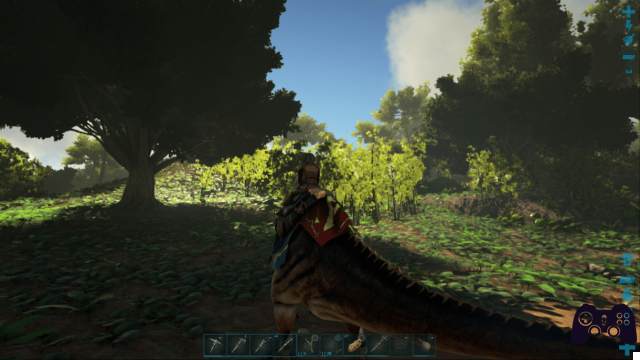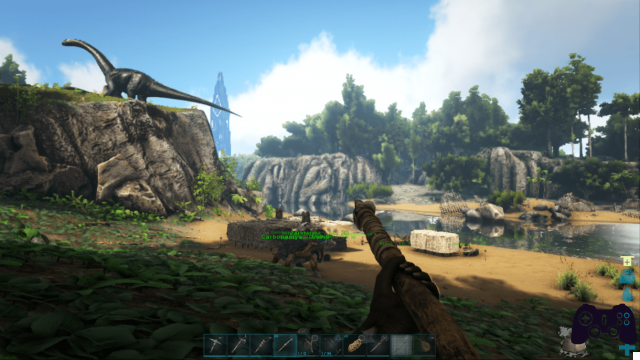Ark: Survival Evolved is a layered work, with many game elements to learn: let's discover today how it is possible to tame most creatures
On the pages of Holygamerz we have been talking about Ark: Survival Evolved for some time. We have proposed our review, a series of anecdotes about our experience with the game through our LIFEinGAMES column and we are here now to introduce the first specific guide.
Today we will talk about how to tame (so-called taming) Ark's creatures.
NB All articles on Ark, unless otherwise specified, refer to The Island map.
Two different types of domestication
To begin with, you need to specify that they exist two different types of domestication modes. There is the aggressive mode and the passive one. Each Ark creature requires one of two methods: it is therefore not possible to choose how to tame (tame) our target. We will have to use the method decided by the game: the only known exception is the Diplodocus (Diplodocus) which accepts both the aggressive and the passive method.
In general, taming revolves around the creature's favorite food. We will have to feed it enough times to make it friendly and make it our ally: a tamed creature will follow us, fight with us, can be used to obtain and transport resources and, in some cases, can be ridden, after manufacturing. the correct saddle.
The main types of food
Let's immediately see the main types of food required by creatures:
- Berries: they are the main livelihood of herbivores. Let's see more precisely how they are divided:
- Improveorbacche: as the name already says, they are the best berries to tame herbivores; the main difference lies not in the taming speed, but in the effectiveness (a feature that we will see later).
- Yellowberries, Blubacche, Tintobacche: standard berries, they have a lower efficiency, but it is much easier to accumulate these three berries, rather than the Improved berries, at least until we can cultivate our plants.
- Vegetables: I'm the Limonedro Lungherba Sassarota and Saporadice; they require to be grown, but are more effective than berries when used as food for herbivores.
- Beef: they are the main sustenance for carnivores, especially terrestrial ones. There are different qualities of meat, but the simplest to accumulate is raw meat: obviously it is not the most effective, but in the initial stages we will not be able to make the precious ones. It can be obtained in large quantities from almost any non-aquatic creature. Creatures also eat cooked meat, but it is less effective.
- Fish: they are the main livelihood of fish eaters, be they birds or reptiles. Fishivores are few, but raw (or cooked) fish can be used as a substitute for raw (or cooked) meat with various carnivores. However, it is not convenient as large quantities would be needed and the domestication effectiveness would suffer. Raw fish can be obtained from any fish: coelacanth, for example, is easy to find and kill in shallow water, as it is not aggressive.
- Kibble: they are an advanced type of feed that always requires an egg from a specific type of dinosaur. Many creatures have a Kibble dedicated to them. In this guide, designed for the initial stages, we will not deal with the Kibble.
Aggressive domestication
The main method of domestication is the aggressive one. Let's see the various steps.
Stopping the Creature: All a matter of Torpor
Our goal is to make the creature "Unconscious". To do this we will have to increase the "Numbness". There are several ways to do this:
- Fists: It is possible to punch creatures, but it is an inefficient method.
- Sling: one of the first methods to increase numbness from a distance; the Sling uses stones as ammunition. It is useful because it allows us to keep our distance from aggressive creatures, as long as we are faster, of course. The Slingshot also does damage to health.
- Wooden club: easy to create and very effective especially with weaker and smaller creatures. The main problem is that non-aggressive creatures will tend to flee and it will not be easy to hit them on the move, while aggressive ones will attack us. A great combo is therefore to use a Ball that holds small to medium dinosaurs in place for thirty seconds. Creatures blocked in this way will not be able to attack, so we can hit them with a bludgeon in the head until they fall to the ground. The Club also does harm to health.
- Narcotic arrows: the narcotic Arrows, to be shot through a bow, increase enemy Torpor the instant they hit the target, and then continue to increase it over the next five seconds. Narcotic Arrows also do health damage, albeit to a much lesser extent than regular stone Arrows.
These are the first methods of increasing enemy torpor available in the early stages of the game.

Let's start taming the creature
As soon as the creature is on the ground, we will be able to approach and interact with it. We will have to open its menu (Y on Xbox One, Triangle on PS4) e put the best food in your inventory. The creature will automatically eat when hungry enough and taming increases. We must be careful not to run out of food, as in this case the taming bar would quickly drop to zero, forcing us to start over.
Another very important bar is that of Numbness: in fact, the creature will not remain on the ground forever. The numbness will drop steadily, at different rates depending on the specimen we are trying to tame. If the numbness dropped to zero, the creature would awaken by fleeing or attacking depending on its temperament. To keep the numbness high, it is necessary to force the animal to eat Narcoberry or Narcotic. The former can be harvested from shrubs, while the Narcotic is to be created in a Mortar and pestle by combining Narcobacche and Rotten Meat. The Narcotic is much more powerful, of course. To force the creature to eat one of the two resources, we will have to put it in its inventory and then use the action command on the object (RT / R2).
By the time the taming bar is at 100%, the creature will be tamed and will start following us. We can give it a name and set its behavior.
The effectiveness of taming
The last bar we will have to keep an eye on is thetaming effectiveness. This bar has a percentage value that will drop as the dinosaur is tamed. As mentioned earlier, the better the food put into the creature, the higher the initial taming effectiveness will be. But what do these numbers indicate?
Quite simply, depending on the effectiveness value, the creature will gain extra levels once it is tamed. The formula to calculate this value is: creature's current level * (tame effectiveness / 2).
Let's take an example. Let's say we're capturing a level 100 creature. The taming effectiveness is and remains at its maximum, which is 99.9%. So, 100lvl * (99.9% / 2) -> 100lvl * (50%) [the value is rounded] -> 50lvl. This means that the creature will receive 50 extra levels once it is tamed: therefore from level 100 it will reach level 150.
Let's repeat it, the taming effectiveness tends to decrease so it will be difficult to keep the percentage value at its maximum.

Passive domestication
There are, however, a whole series of creatures that cannot be tamed in the way just described. The passive method requires you to place the correct food in the last slot on the right of the quick inventory then approach the creature and press the interaction key (Y on Xbox One, Triangle on PS4) when the interaction prompt appears above them. After that we will have to wait until the creature is hungry again and we will have to feed it in the same way. By repeating the process enough times, we will be able to tame the creature.
The main problem is that all creatures (with the exception of the Moscope and the Listrosaurus) will either be frightened by our proximity or will attack us on sight. The best solution is to wear a full Camouflage set so as to be able to approach us undisturbed. The Camouflage set unlocks at level 33 and requires Organic Polymer which can be obtained from two different creatures: the Kairuku which is found only in the northwest of the map The Island and theEsperornis which is common in the southern regions. They are both types of birds. To get as much Organic Polymer as possible you will need to use the wooden club.
Also wearing a Camouflage set however, it is very important not to touch the creature: otherwise it will attack us or flee (depending on the temperament). If you are attacked, you can escape and have the creature calm down and then return to tame it. Remember that a creature that is fighting or feeding on a carcass will not accept your food, so try to clear the area of all distractions if possible.
A few last notes on the world of Ark
We have explained to you all the techniques for taming Ark's creatures in the early stages. Obviously in practice everything is more and more complicated, but with experience you will be able to tame increasingly large and dangerous creatures. The main problem, especially if you play on the online PVP servers, lies in the time required to tame a creature. It will be necessary to have good supplies of Narcobacs and Narcotics, as well as be ready to defend the creature (and ourselves) from all the dangers of the island.






